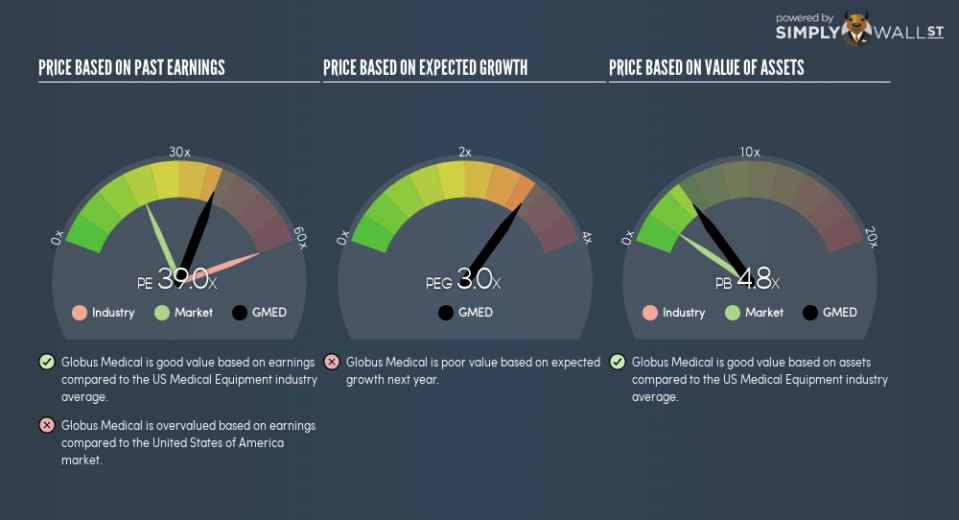Does Globus Medical Inc’s (NYSE:GMED) PE Ratio Warrant A Buy?

This analysis is intended to introduce important early concepts to people who are starting to invest and want to begin learning about how to value company based on its current earnings and what are the drawbacks of this method.
Globus Medical Inc (NYSE:GMED) is currently trading at a trailing P/E of 39x, which is lower than the industry average of 60.1x. While GMED might seem like an attractive stock to buy, it is important to understand the assumptions behind the P/E ratio before you make any investment decisions. Today, I will explain what the P/E ratio is as well as what you should look out for when using it.
Check out our latest analysis for Globus Medical
Breaking down the Price-Earnings ratio
The P/E ratio is one of many ratios used in relative valuation. By comparing a stock’s price per share to its earnings per share, we are able to see how much investors are paying for each dollar of the company’s earnings.
P/E Calculation for GMED
Price-Earnings Ratio = Price per share ÷ Earnings per share
GMED Price-Earnings Ratio = $54.1 ÷ $1.388 = 39x
The P/E ratio itself doesn’t tell you a lot; however, it becomes very insightful when you compare it with other similar companies. We preferably want to compare the stock’s P/E ratio to the average of companies that have similar features to GMED, such as capital structure and profitability. One way of gathering a peer group is to use firms in the same industry, which is what I’ll do. Since GMED’s P/E of 39 is lower than its industry peers (60.1), it means that investors are paying less for each dollar of GMED’s earnings. This multiple is a median of profitable companies of 25 Medical Equipment companies in US including QT Vascular, Lantheus Holdings and Escalon Medical. One could put it like this: the market is pricing GMED as if it is a weaker company than the average company in its industry.
Assumptions to watch out for
Before you jump to conclusions it is important to realise that our assumptions rests on two assertions. The first is that our “similar companies” are actually similar to GMED, or else the difference in P/E might be a result of other factors. For example, if you are comparing lower risk firms with GMED, then its P/E would naturally be lower than its peers, as investors would value those with lower risk at a higher price. The second assumption that must hold true is that the stocks we are comparing GMED to are fairly valued by the market. If this does not hold, there is a possibility that GMED’s P/E is lower because our peer group is overvalued by the market.
What this means for you:
Since you may have already conducted your due diligence on GMED, the undervaluation of the stock may mean it is a good time to top up on your current holdings. But at the end of the day, keep in mind that relative valuation relies heavily on critical assumptions I’ve outlined above. Remember that basing your investment decision off one metric alone is certainly not sufficient. There are many things I have not taken into account in this article and the PE ratio is very one-dimensional. If you have not done so already, I urge you to complete your research by taking a look at the following:
Future Outlook: What are well-informed industry analysts predicting for GMED’s future growth? Take a look at our free research report of analyst consensus for GMED’s outlook.
Past Track Record: Has GMED been consistently performing well irrespective of the ups and downs in the market? Go into more detail in the past performance analysis and take a look at the free visual representations of GMED’s historicals for more clarity.
Other High-Performing Stocks: Are there other stocks that provide better prospects with proven track records? Explore our free list of these great stocks here.
To help readers see past the short term volatility of the financial market, we aim to bring you a long-term focused research analysis purely driven by fundamental data. Note that our analysis does not factor in the latest price-sensitive company announcements.
The author is an independent contributor and at the time of publication had no position in the stocks mentioned. For errors that warrant correction please contact the editor at editorial-team@simplywallst.com.

